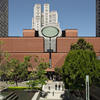More about Collection
- All
- Info
- Shop

Contributor
Robert Rauschenberg created a winning work to make any pack rat proud: an amalgamation of oil paint, fabric, wood, metal and newspaper clippings known as Collection.
While the rest of us store our collected flotsam from life in a drawer or our closets, Robert Rauschenberg pieces them together, throws them on a canvas and hangs it right on the wall.
Collection puts equal importance on found objects like comic strips, magazine illustrations and newspaper clippings as it does on gestural paint strokes and traditional sculptural elements. This piece began Rauschenberg’s tradition of combining painting and sculpture into a single object, an elusive hybrid that he dubbed "the combine." Through this collection of roughly assembled pieces, Rauschenberg created the “vernacular glance”, translating Collection’s sensory overload into a nuanced intersection between art and everyday life. Some critics believe that Rauschenberg used Collection to tussle with his own evolving technique. Even the name of the work was evolving, changing from the time he started in 1954 and not decided until his 1976 retrospective. The name Collection may pay homage to the National Collection of Fine Arts, which was the first stop on the retrospective tour; it may just reference the wayward scraps of everyday life strewn across the composition.
The intersection between art and life doesn’t end with the materials of the piece. Collection has been read as an autobiographical, coded communique to Jasper Johns, Rauschenberg’s love and artistic muse. Rauschenberg used the discarded and mundane objects of the everyday to call attention to the natural intersection between art and life. Rauschenberg famously claimed “[painting] relates to both art and life. Neither can be made. I try to act in that gap between the two.”
He shifted everyone’s attention from that ivory tower of his artistic forefathers to the street and gutter of his contemporary city dwellers. Collection marked Rauschenberg’s break from the traditional boundaries between art, life and society. He didn’t like to behave as expected, he even refused to consider a work “finished”. He had the habit of working on many pieces at once and revisiting and amending those “finished” works, defying the progression of most artists. Even Collection altered slightly each time it was exhibited, as he added some paint here, a comic strip there, and moved various bits around. For Rauschenberg, art, much like life, didn’t have a specific path or end point. He just wanted to bring them into closer proximity. So, trash and refuse became his medium. “A picture is more like the real world when it’s made out of the real world.”
Sources
- Roberts, Sarah. “Rauschenberg Research Project: Collection.” SFMOMA. San Francisco Museum of Modern Art, July 2013. Web. 24 May 2017. https://www.sfmoma.org/artwork/72.26/essay/collection/
- Roberts, Sarah. “Collection.” In San Francisco Museum of Modern Art 360: Views on the Collection. San Francisco, CA, San Francisco Museum of Modern Art, 2016.
- “Robert Rauschenberg, Collection.” Artsy. 2017. Web. 26 May 2017. https://www.artsy.net/artwork/robert-rauschenberg-collection
- “Combine.” Rauschenberg Foundation. The Robert Rauschenberg Foundation, 2017. Web. 6 June 2017. http://www.rauschenbergfoundation.org/art/artwork/collection
- Carpenter, Elizabeth. “Robert Rauschenberg.” Walker Art Center. Walker Art Center, 2005. Web. 5 June 2017. http://www.walkerart.org/collections/artists/robert-rauschenberg












